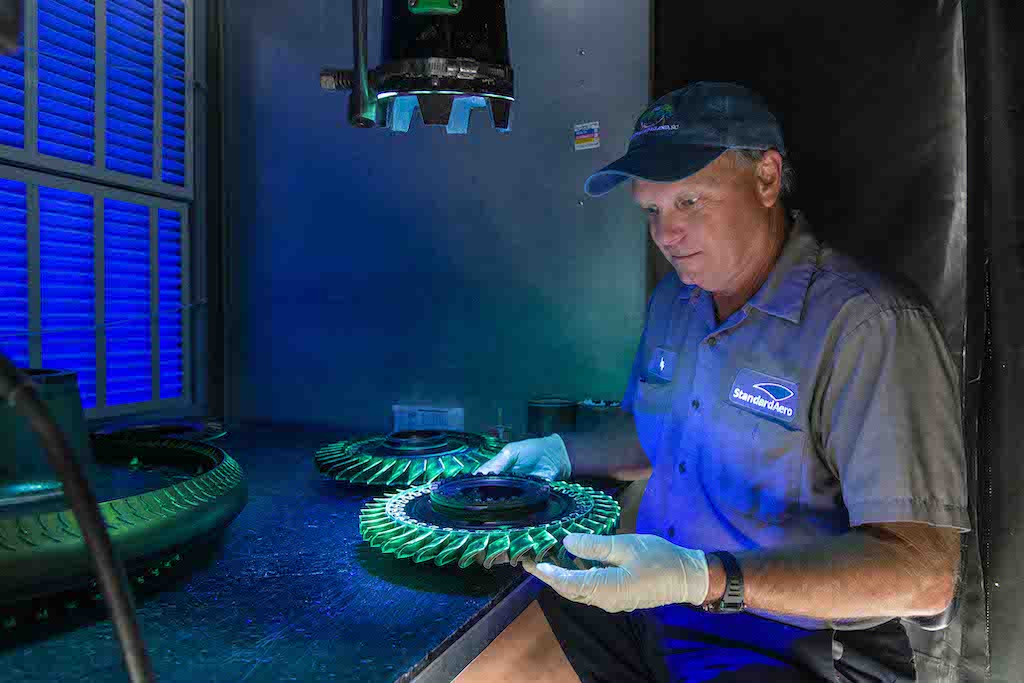As Bizav Flying Rises, MROs Feel Parts Pinch, Part 2

A technician at Duncan Aviation works on the empennage of a large business jet.
Parts supply chain constraints continue to be problematic for business and general aviation MROs in the post-pandemic period. In Part 1 of this article we spoke with Elliott Aviation and Yingling Aviation.
Paul Oneth, Duncan Aviation enterprise material manager and small business liaison officer in Lincoln, Nebraska, observes that parts supply chains are slowly improving, but are still far from optimal.
“It’s still tough regarding everyday items, mostly anything petroleum-based, including rubber and plastic products in general,” Oneth says. “Batteries, adhesives and windshields also continue to be constrained. For electronic LRUs and some engine parts, we are seeing more instances where units are not readily available and have to be worked out of repair.”
Oneth also reports that lead times vary and challenges remain. “There are some products that the manufacturers have (restocked) for AOG aircraft,” he says. “However, for other aircraft, they sit in the hangar, until the parts become available. We have some parts on order right now that we ordered a year ago.”
Prior to the COVID-19 pandemic that was declared in March 2020, there were some items that were hard to get but the situation was nowhere near what prevails today, Oneth stresses. At that time, deliveries could be expected within a few weeks, with most items delivered in about 30 days. “Now, 90 days is more common, and deliveries often get pushed out past the lead times,” he says.
As examples, Oneth reports that composite panels, which once had a lead time of approximately eight weeks, are now arriving upward of 40 weeks-plus. “I have had spline extractors on order since February [2022] and we are now just starting to get a few in here and there,” he says. “Most of our items, pre-pandemic, were usually in stock and ready to ship when we ordered them. Parts that we used to get the next day are having lead times in excess of 20 weeks.”
Part of the blame for prolonged lead times rests on those who supply the suppliers, as well as on transportation issues, Oneth says.
“Suppliers are passing on their manufacturers’ lead times which sometimes get pushed out,” Oneth reports. “They will check with the manufacturer and call us back with a due date. When that date comes and we still have no parts, we call again, and the date is pushed out another month. It just keeps getting pushed out with no definite due date.”
Engine Parts Shortage

Chris Bodine, vice president and general manager of StandardAero’s Augusta, Georgia, business aviation MRO facility, says there is currently no change to the “very difficult” parts supply situation, with signs that it might be getting worse.
“The depth of the parts delays is deeper and longer than it was at the beginning of the pandemic,” Bodine notes. “[2022] was much worse than 2021—which was worse than 2020—and 2023 looks to be equally as bad. While hot section components—particularly the turbine components, including blades—are the most constrained, there is also shortage of all engine parts that are cast from precious metals.”
Bodine paints a sobering picture of what could lie ahead.
“The problem seems to be a supplier constraint, but we have to wonder what the raw material situation will be in the future, especially the longer the Ukraine situation goes on,” Bodine cautions. “Ultimately, we could have bigger problems coming from raw metals supply availability.”
As Bizav Flying Rises, MROs Feel Parts Pinch, Part 1: https://aviationweek.com/business-aviation/maintenance-training/bizav-f…


